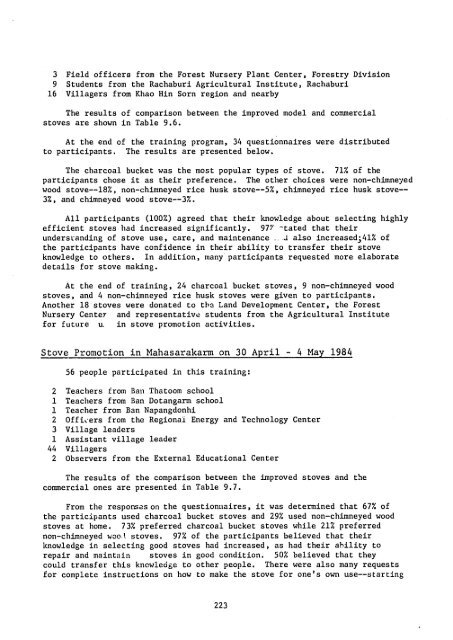improved biomass cooking stove for household use - (PDF, 101 mb ...
improved biomass cooking stove for household use - (PDF, 101 mb ...
improved biomass cooking stove for household use - (PDF, 101 mb ...
You also want an ePaper? Increase the reach of your titles
YUMPU automatically turns print PDFs into web optimized ePapers that Google loves.
3 Field officers from the Forest Nursery Plant Center, Forestry Division<br />
9 Students from the Rachaburi Agricultural Institute, Rachaburi<br />
16 Villagers from Khao Hin Sorn region and nearby<br />
The results of comparison between the <strong>improved</strong> model and commercial<br />
<strong>stove</strong>s are shown in Table 9.6.<br />
At the end of the training program, 34 questionnaires were distributed<br />
to participants. The results are presented below.<br />
The charcoal bucket was the most popular types of <strong>stove</strong>. 71% of the<br />
participants chose it as their preference. The other choices were non-chimneyed<br />
wood <strong>stove</strong>--18%, non-chimneyed rice husk <strong>stove</strong>--5%, chimneyed rice husk <strong>stove</strong>-<br />
3%, and chimneyed wood <strong>stove</strong>--3%.<br />
All participants (100%) agreed that their knowledge about selecting highly<br />
efficient <strong>stove</strong>s had increased significantly. 977 -tated that their<br />
undersvanding of <strong>stove</strong> <strong>use</strong>, care, and maintenance .J also increased;41% of<br />
the participants have confidence in their ability to transfer their <strong>stove</strong><br />
knowledge to others. In addition, many participants requested more elaborate<br />
details <strong>for</strong> <strong>stove</strong> making.<br />
At the end of training, 24 charcoal bucket <strong>stove</strong>s, 9 non-chimneyed wood<br />
<strong>stove</strong>s, and 4 non-chimneyed rice husk <strong>stove</strong>s were given to participants.<br />
Another 18 <strong>stove</strong>s were donated to the Land Development Center, the Forest<br />
Nursery Center and representative students from the Agricultural Institute<br />
<strong>for</strong> future u in <strong>stove</strong> promotion activities.<br />
Stove Promotion in Mahasarakarm on 30 April - 4 May 1984<br />
56 people participated in this training:<br />
2 Teachers from Ban Thatoom school<br />
1 Teachers from Ban Dotangarm school<br />
1 Teacher from Ban Napangdonhi<br />
2 Offi ers from the Regional Energy and Technology Center<br />
3 Village leaders<br />
1 Assistant village leader<br />
44 Villagers<br />
2 Observers from the External Educational Center<br />
The results of the comparison between the <strong>improved</strong> <strong>stove</strong>s and the<br />
commercial ones are presented in Table 9.7.<br />
From the responses on the questionnaires, it was determined that 67% of<br />
the participants <strong>use</strong>d charcoal bucket <strong>stove</strong>s and 29% <strong>use</strong>d non-chimneyed wood<br />
<strong>stove</strong>s at home. 73% preferred charcoal bucket <strong>stove</strong>s while 21% preferred<br />
non-chimneyed woo.k <strong>stove</strong>s. 97% of the participants believed that their<br />
knowledge in selecting good <strong>stove</strong>s had increased, as had their ability to<br />
repair and maintain <strong>stove</strong>s in good condition. 50% believed that they<br />
could transfer this knowledge to other people. There were also many requests<br />
<strong>for</strong> complete instructions on how to make the <strong>stove</strong> <strong>for</strong> one's own <strong>use</strong>--starting<br />
223

















